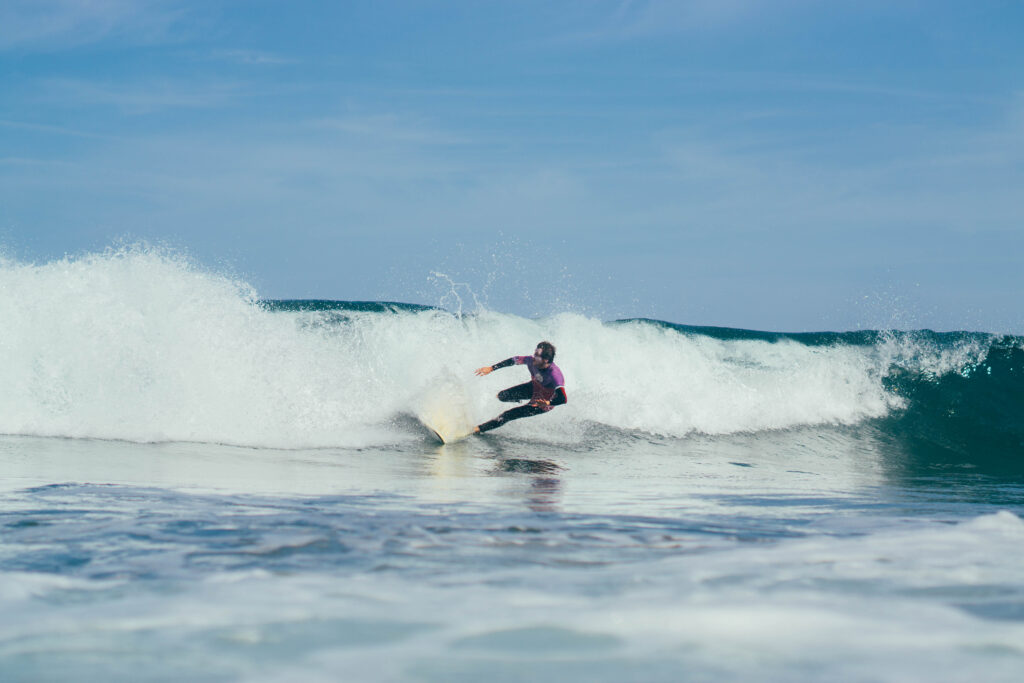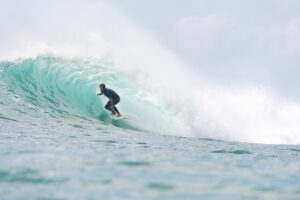
Learning to surf broken waves is a process that requires practice and perseverance. To speed up your learning process, it is essential to identify and correct the most common mistakes before they become ingrained habits.
In this article, we’ll show you the 10 most common mistakes we make when learning to surf broken waves, along with tips to correct them.
1. Paddling The Wrong Part Of The Wave
A common mistake is to paddle into a wave when the slope is too gentle or too steep. To catch more waves, it’s critical to position yourself precisely on the proper slope. Imagine a skateboard ramp: the steeper it is, the more acceleration you’ll get. The same goes for the waves: the bigger and steeper they are, the more lift they will give you, although it will also be more difficult to take off.
2. Don’t Look Over Your Shoulder
Not looking over your shoulder is closely related to the first mistake. In fact, not looking over your shoulder is often the cause of not paddling into the proper wave shape. The only way to improve your positioning on the slope is to look over your shoulder. As long as you’re paddling to Stage A or C without looking over your shoulder at the wave, you’re not training your mind to quickly recognize the proper wave shape.
3. Using A Surfboard That Is Too Small
Another common mistake is using a surfboard that is too small. If you use a larger board, you will have the flexibility to catch the wave earlier in the B-stage, since you won’t be relying as much on gravity and a steep slope to enter the wave. In contrast, on a shorter board, your paddling speed will initially be limited, which can make it difficult to aim for steeper inclines, especially if you’re in the early stages of learning. A bigger board will make the learning process easier and more fun.
4. Fear Nose Dives
There are many misconceptions about “nose dives” that can lead to problems and bad habits. One of the common mistakes is that beginners think they are sinking on their toes because they have too much weight on the front of the board. This can cause them to pull back and build drag, making it difficult for them to catch up to wave speed. You shouldn’t be afraid of nose dives. In fact, you need to maintain the highest possible paddling speed and, in most cases, keep your head down to put weight on the nose of the board.
5. Not Learning In The Right Place Or Conditions
Each surf spot has unique characteristics, such as the relief of the seabed, the breaking speed of the waves, the influence of the tide, the wind, and the direction of the swell, among other factors. Learning in a place where the waves break sharply on a tide or in an unfavorable wind will make it difficult for you to learn. It is important to find out about the surf spot near you and the best conditions to practice.
6. Not Using The Weight Of The Head Properly
Proper use of head weight when riding straight waves is critical. Tilting your head down and closer to the nose of the board as you rise up on a wave, will make all the difference in your ability to catch, keep your balance, and follow the speed of the oncoming water. Take advantage of the momentum generated by getting up on the wave and keep your head down to improve your ability to catch unbroken waves.
7. Not Keeping Your Head Down When Riding The Wave
Keeping your head low as you ride the wave prevents excess drag and helps you maintain speed and stability. Avoid sudden head movements, as these will cause the board to rock up and down, interrupting the flow of water under it. This will generate more drag and less speed, making it harder to catch waves.
8. Take A Few Extra Strokes Before Taking Off
Even when you have a proper position on the wave in stage B, a fast paddling speed, and use your head weight to enter an unbroken wave, problems can still arise when sliding and keeping your balance. At that point, it’s critical to remember to take two or three extra strokes before taking off. This will ensure that you have reached the proper speed before starting the slide. If you skip this step, you risk missing the wave when trying to take off. On the other hand, in opposite situations, you may keep paddling for too long, which can cause you to slide in the wave to the bottom while still lying on the board. It is important to have the feeling that you have started to ride the wave properly.. With practice, you’ll improve your ability to recognize when you’ve rowed enough.
9. Don’t Paddle Too Steeply For A Wave
When you start learning how to adjust your launch angle, it’s a good idea to focus on the angle only on the last two or three strokes to maximize your chances of catching the wave. Paddling at too much of an angle will hinder your ability to catch unbroken waves. Keep a more neutral angle on most of your strokes and focus angle adjustment only on the last few strokes before launch.
10. Don’t Change Your Paddling Technique When Catching A Wave
If you want to move quickly through the water, it’s important to maximize the surface area of your stroke to build momentum back. Therefore, your paddling technique should not change too much when catching a wave. The theory explained in our tutorial on maximizing propulsion is still relevant. The difference is that the frequency of your paddles increases as you get closer to catching the wave since it is crucial to paddle hard at that moment. Experienced surfers keep the same efficient paddling technique, but increase the number of strokes per minute, minimizing the time between hands leaving the water and re-entering for another stroke.
If you want to accelerate your progress in surfing, connect with a community of like-minded surfers, and strengthen your knowledge of the fundamentals of surfing techniques, visit us at our surf camp in Lanzarote, Canary Islands.





